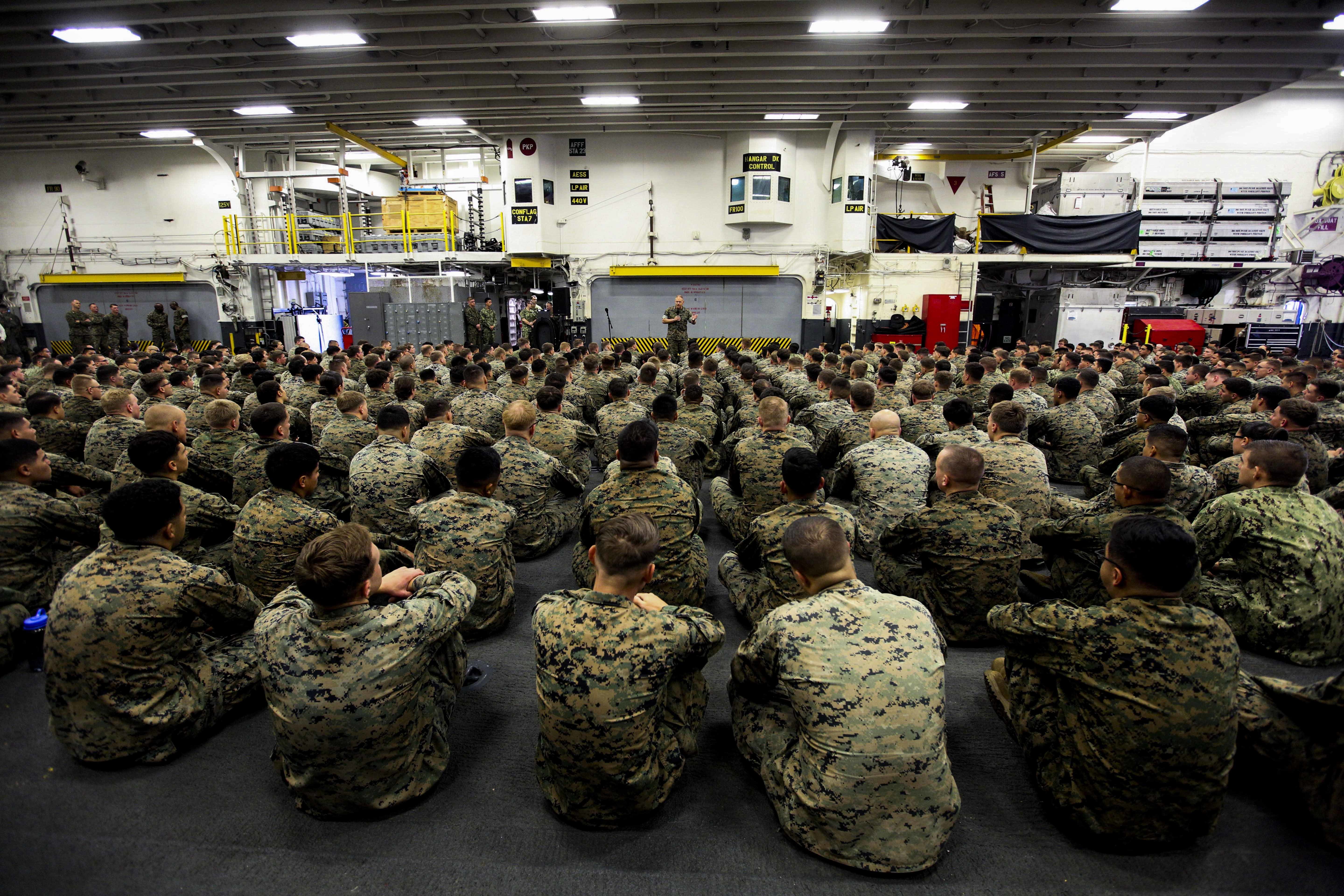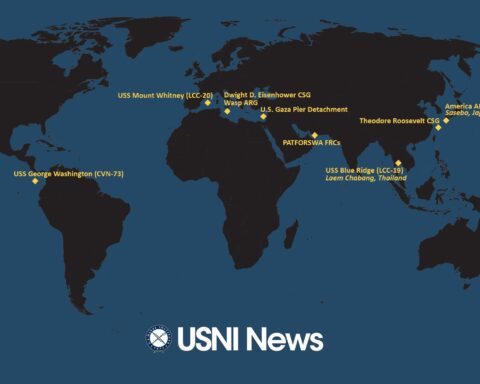
The USNI News Fleet and Marine Tracker is sponsored by CNA. These are the approximate positions of the U.S. Navy’s deployed carrier strike groups and amphibious ready groups throughout the world as of June 11, 2018, based on Navy and public data. In cases where a CSG or ARG is conducting disaggregated operations, the map reflects the location of the capital ship.
Total U.S. Navy Battle Force:
283
Ships Underway
| Deployed Ships Underway | Non-deployed Ships Underway | Total Ships Underway |
| 45 | 18 | 63 |
Ships Deployed by Fleet
| Fleet Forces | 3rd Fleet | 4th Fleet | 5th Fleet | 6th Fleet | 7th Fleet | Total |
| 1 | 1 | 0 | 15 | 24 | 47 | 88 |
In the Mediterranean Sea

The Harry S. Truman Carrier Strike Group (CSG) has resumed strikes against Islamic State targets in Syria, launching fighters from the Mediterranean Sea, the Navy announced on Monday.
“Bringing the Harry S. Truman strike group back into the fight against ISIS sends a powerful message to our partners that we are committed to peace and security in the region, and anywhere threatened by international terrorism,” Rear Adm. Gene Black, commander of the Harry S. Truman CSG, said in a Monday statement.
“Once again we demonstrate the incredible flexibility and capabilities of a carrier strike group; we are combat-proven and ready to answer the call anytime and anywhere to carry out any mission we are directed.”
Last week, elements of Carrier Air Wing 1 embarked on USS Harry S. Truman (CVN-75) supported the ongoing BALTOPs exercise in the Baltic Sea.
Flight operations over Europe from the Adriatic Sea “represented the first instance that U.S. carrier aircraft have participated in the exercise, which began in 1972 and is now in its 46th year,” according to a U.S. 6th Fleet statement.
“F/A-18 Super Hornet strike fighter aircraft and E/A-18G Growler electronic attack aircraft joined aircraft from Poland, Spain and U.S. Air Forces Europe to demonstrate the ability to perform combined air operations while communicating and coordinating effectively.”
Carrier Strike Group 8

Aircraft carrier:
USS Harry S. Truman (CVN-75), homeported in Norfolk, Va.
Carrier Air Wing 1

CVW 1 from Naval Air Station Oceana, Va., is embarked aboard Harry S. Truman and includes nine squadrons and detachments:
- The “Red Rippers” of Strike Fighter Squadron (VFA) 11 from Naval Air Station Oceana, Va.
- The “Checkmates” of VFA-211 from Naval Air Station Oceania, Va.
- The “Sunliners” of VFA-81 from Naval Air Station Oceana, Va.
- The “Knighthawks” of VFA-136 from Naval Air Station Lemoore, Calif.
- The “Rooks” of Electronic Attack Squadron (VAQ) 137 from Naval Air Station Whidbey Island, Wash.
- The “Seahawks” of Carrier Airborne Early Warning Squadron (VAW) 126 from Naval Air Station Norfolk, Va.
- The “Rawhides” of Fleet Logistics Support Squadron (VRC) 40 from Naval Air Station Norfolk, Va.
- The “Dragon Slayers” of Helicopter Sea Combat Squadron (HSC) 11 from Naval Air Station Norfolk, Va.
- The “Proud Warriors” of Helicopter Maritime Strike Squadron (HSM 72) from Naval Air Station Jacksonville, Fla.
Destroyer Squadron 28
The leadership of DESRON 28 is embarked aboard Harry S. Truman and commands the CSG’s guided-missile destroyers.
- USS Farragut (DDG-99), homeported in Mayport, Fla.
- USS Forrest Sherman (DDG-98), homeported in Norfolk, Va.
- USS Bulkeley (DDG-84), homeported in Norfolk, Va.
- USS Arleigh Burke (DDG-51), homeported in Norfolk, Va.
The Sachsen-class German frigate FGS Hessen (F 221) is also operating as part of the strike group during the first half of the deployment.
USS The Sullivans (DDG-68) deployed from Mayport, Fla., on May 26 and fired a Standard Missile (SM-2) for training on May 28 in the Virginia Capes. The Sullivans and USS Jason Dunham (DDG-109) will join the Truman CSG in theater.
Guided-missile Cruiser
USS Normandy (CG-60), homeported in Norfolk, Va.
In the Baltic Sea

Dock landing ship USS Oak Hill (LSD-51) and components of the 26th Marine Expeditionary Unit (MEU) are participating in BALTOPS 2018. U.S. 6th Fleet flagship USS Mount Whitney (LCC-20) is also part of the 46th annual iteration of the exercise.
Running until June 15, “BALTOPS is an annual joint, multinational maritime-focused exercise. It is designed to improve training value for participants enhance flexibility and interoperability, and demonstrate resolve among allied and partner forces in defending the Baltic Sea region,” according to the Navy.
“The exercise will involve maritime, ground, and air forces so as to strengthen combined response capabilities necessary to ensure regional stability.”
Participating nations include Belgium, Denmark, Finland, France, Germany, Latvia, Lithuania, the Netherlands, Norway, Poland, Romania, Spain, Sweden, Turkey, the U.K. and the U.S.

More than 60 aircraft, 42 ships and a submarine, and a combined amphibious landing force are scheduled to participate in BALTOPS 2018.
In Japan

Hospital ship USNS Mercy (T-AH-19) arrived in Yokosuka, Japan, on June 10.
Amphibious assault ship USS Wasp (LHD-1) is in port in Sasebo, Japan.
In the Philippine Sea

The Ronald Reagan Carrier Strike Group is participating in Malabar 2018 exercise.
“This is the first year Guam is hosting the annual exercise in which participants will practice surface and anti-submarine warfare operations, combined carrier strike group operations, maritime patrol and reconnaissance operations, and visit, board, search, and seizure operations,” according to a Navy statement.
USNI News reported last week, that, “while not mentioned in any public statements released by the Malabar participants, the recent activities of China, notably its program of building artificial islands in the South China Sea and sending submarines into the Indian Ocean, loom over the exercise.”
The Reagan CSG departed Yokosuka, Japan, on May 29.
Carrier Strike Group 5

Aircraft carrier:
USS Ronald Reagan (CVN-76), homeported in Yokosuka, Japan
Carrier Air Wing 5

CVW 5, based at Naval Air Facility Atsugi and Marine Corps Air Station Iwakuni in Japan, is embarked aboard Ronald Reagan and includes a total of nine squadrons and detachments:
- The “Royal Maces” of Strike Fighter Squadron (VFA) 27 from Marine Corps Air Station Iwakuni, Japan
- The “Diamondbacks” of VFA-102 from MCAS Iwakuni, Japan
- The “Eagles” of VFA-115 from MCAS Iwakuni, Japan
- The “Dambusters” of VFA-195 from MCAS Iwakuni, Japan
- The “Shadowhawks” of Electronic Attack Squadron (VAQ) 141 from MCAS Iwakuni, Japan
- The “Tiger Tails” of Carrier Airborne Early Warning Squadron (VAW) 125 from MCAS Iwakuni, Japan
- The “Providers” of Fleet Logistics Support Squadron (VRC) 30 from Naval Air Facility Atsugi, Japan
- The “Golden Falcons” of Helicopter Sea Combat Squadron (HSC) 12 Naval Air Facility Atsugi, Japan
- The “Saberhawks” of Helicopter Maritime Strike Squadron (HSM) 77 from Naval Air Facility Atsugi, Japan
Destroyer Squadron 15

DESRON 15 leadership is embarked aboard Ronald Reagan and commands the strike group’s guided-missile destroyers. Reagan is employing part of the squadron, which also deploys for other missions in the region.
- USS Mustin (DDG-89), homeported in Yokosuka, Japan
Guided-missile Cruisers
- USS Antietam (CG-54), homeported in Yokosuka, Japan
- USS Chancellorsville (CG-62), homeported in Yokosuka, Japan
In the Gulf of Aden

The amphibious assault ship USS Iwo Jima (LHD-7) is operating in the Gulf of Aden. The Amphibious Ready Group (ARG) has been operating in a disaggregated manner in the last several weeks, with some units in the Mediterranean Sea, some in the Red Sea and some in the Baltic Sea. The ARG recently celebrated its halfway completion of deployment.
The Iwo Jima ARG with the 26th MEU deployed on Feb. 7 from Mayport, Fla. The ARG includes Iwo Jima, Oak Hill, amphibious transport dock USS New York (LPD-21), Fleet Surgical Team (FST) 8 and FST-4, Helicopter Sea Combat Squadron (HSC) 28, Tactical Air Control Squadron (TACRON) 22, components of Naval Beach Group (NBG) 2 and the embarked staff of Amphibious Squadron (PHIBRON) 4.
In the Western Atlantic

USS George H. W. Bush (CVN-77) is currently in the Virginia Capes Operating Areas for training.
USS Kearsarge (LHD-4) is at U.S. Naval Weapons Station Earle located in Colts Neck, N.J. loading aboard ammunition ahead of a planned exercise.

NWS Earle was commissioned in late 1943. The waterfront complex and the pier stretch almost three miles into the Sandy Hook Bay. The station’s pier complex is one of the longest “finger piers” in the world. At the junction of Piers 2, 3 and 4 a concrete platform supports the port operations building and a few other structures known as the “wye.”
In the Eastern Pacific

The Essex ARG/13th MEU is underway for its Composite Training Unit Exercise (COMPTUEX), the final exercise before the units’ upcoming deployment. This exercise validates the ARG/MEU team’s ability to adapt and execute missions in ever-changing, unknown environments. Upon completion of COMPTUEX, the 13th MEU and Essex ARG will be certified to deploy.
Last week, Commandant of the Marine Corps Gen. Robert Neller visited USS Essex (LHD-2) and addressed 13th MEU Marines.
Essex ARG and 13th MEU will conduct the first-ever West Coast deployment of the Marine variant of the F-35B Lighting II Joint Strike Fighter. In March, the Marine F-35Bs deployed from the Japan-based USS Wasp (LHD-1).
In addition to these major formations, not shown are thousands of others serving in submarines, individual surface ships, aircraft squadrons, SEALs, Special Purpose Marine Air-Ground Task Forces, Coast Guard cutters and more serving throughout the globe.





